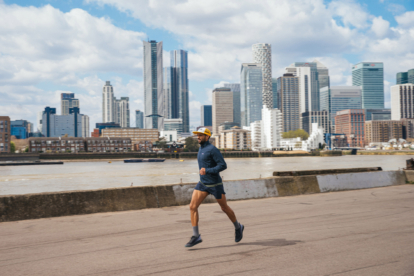Dark River Runs Deep
An attempt to set the fastest known time on the 184-mile path to the source of the River Thames.
“And this also, “said Marlow suddenly,” has been one of the dark places of the earth.”
So begins Heart of Darkness—the classic novel from Joseph Conrad. Heart of Darkness is a brooding literary critique of colonialism. First published in 1899, it loosely follows the author’s youthful experience as an “accidental captain” of a Belgian colonial steamer on the Congo River. The story is a narrative within a narrative, a tale told to a small and attentive crew of friends in a still night waiting for the tide at the eastern reaches of the Thames. It’s no coincidence that these waters are where ideas of colony and empire were born—and where the traders and the slavers set out on their journey to rule the waves and extract what they could from the people and earth of the world. In Conrad’s book, the Congo is a conduit, which metaphorically meanders deep into Heart of Darkness. The Thames, meanwhile, on which he delivers the narrative, is its mirror image. But there is no shimmering light to which this English waterway reflectively leads. Way up the River Thames, there is an even darker dread.
For the first 80 miles, I was joined by pacers from the Black Trail Runners community. In that period everything was going great. It was on a paved section. I was on target pace. Everything was going perfectly. Then as night came in, a couple of the pacers had dropped out. That is when darkness came. The temperature dropped, and the conditions underfoot changed rapidly into this muddy quagmire. There was mist coming off the Thames, so visibility was low. I was on my own with a head torch. I was 13 or 14 hours in. I think reality hit me then.
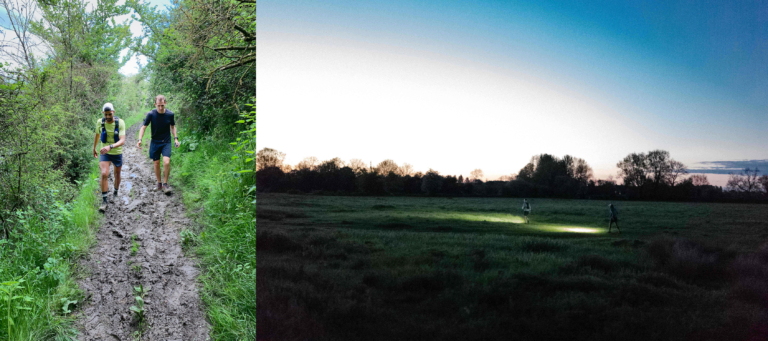
Left: Navigating mud is just a little better with friends. Photo: Phil Young
Right: Stretching the light. Photo: Holly-Marie Cato
There was always a metaphorical potency to the idea: a man whose heritage is partly from the continent that was carved up between the colonial powers, and whose people were enslaved and shipped away from their established civilizations, setting the fastest known time for a journey to the source of Britain’s iconic waterway. Martin “MJ” Johnson is a son of the British Islands and a native of the river side. He grew up in Downham, a district of Southeast London a few miles south of the eastern shores of the Thames where Conrad set his narrative. Downham is a classic town within a big urban conurbation, like countless others that developed rapidly in Britain after World War II. Areas like this were meant to ease the housing crisis—part of a vision of decent housing and gardens for all—a noble, rose-rendered ideal for the working classes. It worked, to an extent. But the idea turned sour for many. A generation grew and moved on, and new families took their place. By the 1980s, when MJ was a young kid, the dream of civic utopia began to fade, replaced by the discontents of a society shot through with a class system and an endemic form of racism whose roots lead right back to the colonial impulse that Conrad critiqued.
I knew Southeast London well. I understand its reality. But I also have this postcard image of the city. People talk about London as this diverse pot of culture. There is this image of London that people want you to see. I associate that with the river and the various riverside moments, like Tower Bridge, the Thames Barrier and all these iconic “postcard” images of the Thames. You grow up identifying with that version of London, the one that everyone wants you to see. But in the last two years, I have been questioning that image. I’ve been facing some of those questions. I have realized that there are experiences I have had in my life as a man of mixed heritage that I have perhaps ignored—all in order for me to fit that idealized image of this city.
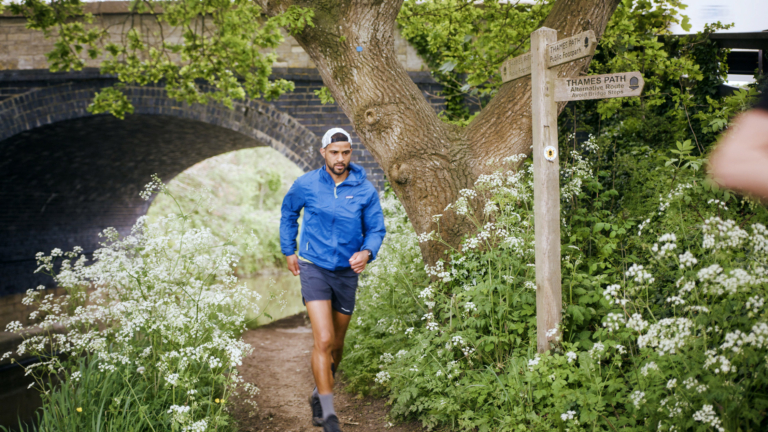
Martin Johnson somewhere between the known and the unknown. Photo: Matt Kay
When you run ultras, you dig deep. There is an incessant rhythm that you must locate, embrace, and with which you must dance. Every runner develops a private and obtuse romance with the pain and the drama, the inward conversations and the external dialogue with what it means to run. Why? How? What is this thing? To run absurd distances, alone, deepens and broadens the power of those conversations. But this run has another layer. It’s invisible to most. But for Martin, it is written on the body. This run means more than a fastest known time. Its resonance extends beyond digits and a performance statistic. But does the run itself reveal some kind of truth about Martin, about London, about the relationship between the two?
In that spell in the darkness, solo, I started getting these issues with my knee and calf. I ran through that. The next marker was the 100 miles at Henley. I had my crew there. They lifted me. But I knew at that stage that the final 50 miles, all through the night, was going to be the toughest. I wasn’t expecting the conditions I was met with. In the film footage, you can see the physical decline in me. I hadn’t experienced that before. I had done 100-milers before, and because I had finished them in 15 hours or so, I had never had to run entirely through the night and continue running. That was part of the new experience …
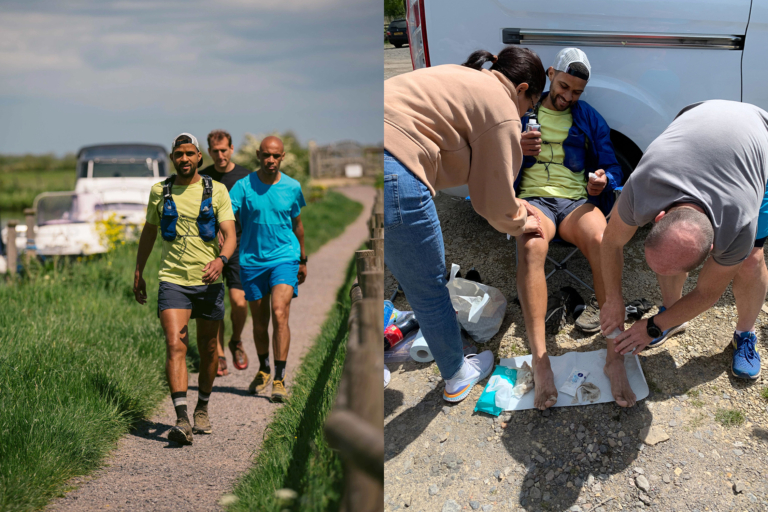
Left: Support is essential. Photo: Holly-Marie Cato
Right: So is foot care. Photo: Phil Young
As you move from the eastern reaches of the Thames, you pass the ghosts of empires and docks named after the great wealth-stores of the crown, names like East India dock, the Custom House and Limehouse. It is a litany of exploitation encoded deeply into the vernacular of London. These docks and landing places, the warehouses now converted to apartments for the super-rich, are where the raw material of entire continents were processed. It is where imperial plunder was factored, taxed, tallied and distributed. It was where spices and minerals, metals and textiles, and visceral humanity was converted into lucre, which in turn bestowed power and influence. Amongst the discarded hulks of heavy industry that line the riverbank, there are ghosts and demons at work. The traditionally sacred places where waters meet, where the Thames sends out its tributaries north and south (and where London’s first cultural layer was formed and to which Conrad referred to in his opening statement) are ragged weigh stations condemned to post-industrial bleakness and nature reserves stewarded by a generation who have glimpsed the endgame.
In ultrarunning, you have to dive through the tough things. I was looking for sunrise to give me a lift. But when it came and I was still struggling, I started searching around for other things: a new gel or a pacer. You are constantly trying to latch onto something, but there is this need for patience. People talk about the “pain cave” and going to these dark places; my mindset is different. You want to stay just on the right side of comfortable for the entire journey. I love that patience of just allowing the race and time to unfold and enjoying the journey. This was the first time that it didn’t quite work, and I guess I entered that pain cave for the first time. That is the first time I have experienced that feeling of, how do I keep moving? How do I get this done?
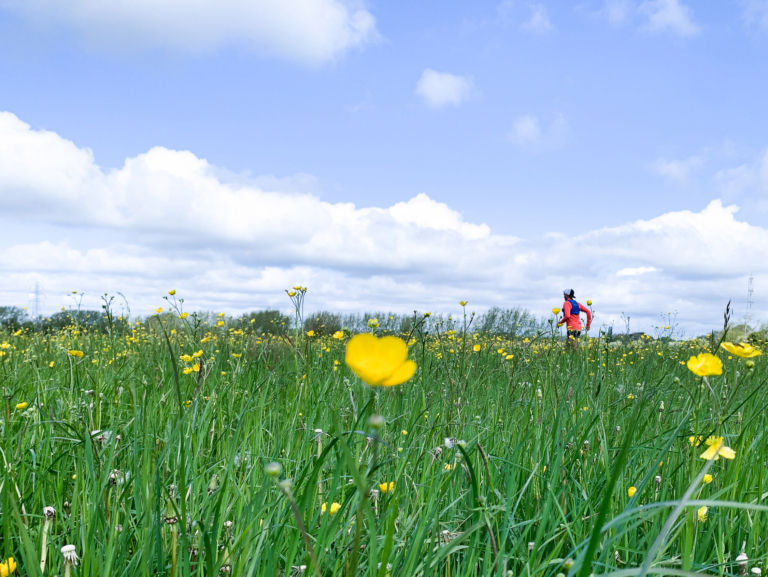
The trail passes all kinds of landscapes. Photo: Phil Young
Is it possible to define what Britain is by the wealth and the influence that was trafficked via its waterways? Have the people who live on these islands come to terms with their history? And do enough of them even know the darkness that resides in the pages of that history? Whatever you believe and whatever words are spoken about the issues of colonialism and imperialism, and how it resonates, it is actions like MJ’s run—deeds rather than words—that shine real light. We are distillations of everything that has gone before, flowerings of the universe that express everything. We shouldn’t be ashamed. We should find the courage to tackle our dark histories and the parts in them which we play.
I have mixed emotions about what I did. I set out for a much faster time, so I am not embarrassed, but it wasn’t the statement time I wanted to lay down. But when I hear from people across the running community how that has inspired them, it makes it better. People have taken to the trails, and people have contacted me and told me how inspired they have been by the run. People have told me that it has been their inspiration. That allows me to own that and accept it. We were trying to inspire others. There was a physical challenge. But we were trying to tell a story as well. Personally, I went to some dark places for the first time. I’m not sure how much of that was purely physical and how much was about the story. Ultimately, they are all part of the same thing, aren’t they?
